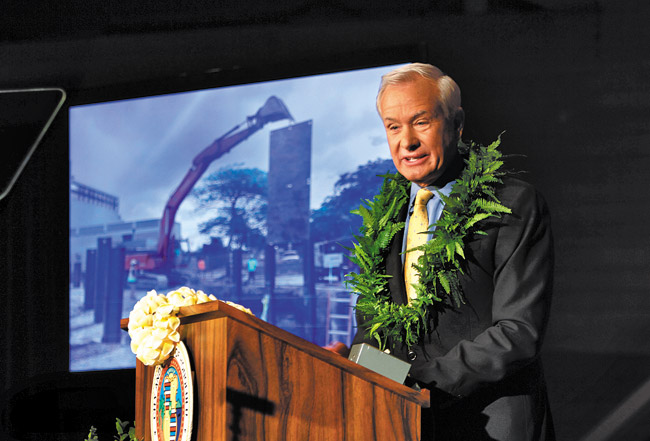Potholes, Sewers And Name-dropping

Mayor Kirk Caldwell delivered his State of the City speech last week Dennis Oda / Honolulu Star-Advertiser photo
A formula exists for “states of,” as in State of the Union, State of the State or, one of the variety Kirk Caldwell delivered last week, a State of the City.
All invoke political luminaries, past and present. All include a brag session: “Look at all the amazing things my administration did for you last year.” And all finish with promises of more wondrous accomplishments to come.
Mayor Caldwell followed the formula in his 2014 State of the City. He began by invoking the name of the late, much-revered Nadao Yoshinaga. As a state senator, Yoshinaga helped create the State Foundation on Culture and the Arts and the employer mandate in the state’s health care system. When Caldwell once asked him what he would have done differently, Yoshinaga responded: “I would have dreamed bigger dreams.”
But the formula calls for bragging before dreams, so the mayor talked about filling potholes. He reminded his audience that he’d promised “to refinish all our substandard roads in four years,” at the rate of 300 miles per year. In his first year, he reported, the city had repaved a whopping 398 miles.
“Wherever I go,” said His Honor immodestly, “people come up to me and thank me for repaving their road, or say they already see a difference in the condition of our roads.”
Then he turned to sewers, progress in the repair of which people have a more difficult time seeing. Caldwell offered no rhetorical flourishes here, just talk of dollars spent, flow tunnels, pump stations, collector systems and first digesters. Yep, first digesters. Murky stuff, sewers, that evoke murky images.
Caldwell also spoke of the city’s restoration of nine bus routes that had been canceled by the previous administration.
“Public transportation,” he said, “is about social equity.”
Transportation includes fixed rail mass transit, which Caldwell promised “to build better” during his campaign for mayor. He noted that his administration had maintained “fiscal and management transparency” regarding rail, that it had “cleared all major legal hurdles,” and that Honolulu
Area Rapid Transit authority currently was “going gang-busters,” building columns and foundations. Caldwell invoked no less than Michelle Obama as a transit expert: “I heard you’re building rail mass transit. That’ll be a game-changer.”
Caldwell could not avoid Honolulu’s homeless problem: ” … the visual and physical impact of homelessness … generates more complaints than any other issue.” He offered a glimmer of hope, a program called Housing First that has showed promise in Mainland cities. It finds housing for the homeless, then provides services to help them deal with their addictions. Caldwell quoted Barack Obama to introduce a bigger dream: “Transit is not about getting someplace,” according to the president. “It’s about building a better place.”
Caldwell said transit-oriented development provided an “opportunity to build new neighborhoods” that would provide middle-class housing.
Not so big was the mayor’s image of separated bike paths winding through those new neighborhoods, unlike the city’s current lanes that “barely tolerate” bike riders. And they would be lit at night by new, more energy-efficient LED lights, saving the city some $3 million per year.
Caldwell’s last luminary was Chicago Mayor Rahm Emmanuel, who, in a moment of mutual self-congratulation, had told Caldwell that given Washington’s grid-lock, city government is where the action is.
Perhaps it is. Those newly paved streets and sewer repairs won Caldwell a 72 percent approval rating in the Star-Advertiser‘s recent Hawaii Poll. No small feat that.
dbboylan@yahoo.com





